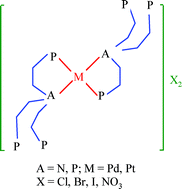Tripodal polyphosphine ligands as inductors of chelate ring-opening processes in mononuclear palladium(ii) and platinum(ii) compounds. The X-ray crystal structure of two derivatives containing dangling phosphorus†
Abstract
The reaction of NP3 (

* Corresponding authors
a
Departamento de Química Inorgánica, Universidad de Santiago de Compostela, Avda. de las Ciencias, Santiago de Compostela, Spain
E-mail:
mesther.garcia@usc.es
Fax: 34-981-597525
Tel: 34-981-563100/14241
The reaction of NP3 (

 Please wait while we load your content...
Something went wrong. Try again?
Please wait while we load your content...
Something went wrong. Try again?
D. Fernández-Anca, M. I. García-Seijo and M. E. García-Fernández, Dalton Trans., 2010, 39, 2327 DOI: 10.1039/B912678C
To request permission to reproduce material from this article, please go to the Copyright Clearance Center request page.
If you are an author contributing to an RSC publication, you do not need to request permission provided correct acknowledgement is given.
If you are the author of this article, you do not need to request permission to reproduce figures and diagrams provided correct acknowledgement is given. If you want to reproduce the whole article in a third-party publication (excluding your thesis/dissertation for which permission is not required) please go to the Copyright Clearance Center request page.
Read more about how to correctly acknowledge RSC content.
 Fetching data from CrossRef.
Fetching data from CrossRef.
This may take some time to load.
Loading related content
